BUMGT5980 - Managerial Decision Making: Biases and Rational Behaviour
VerifiedAdded on 2022/10/09
|7
|2173
|404
Essay
AI Summary
This essay critically examines decision-making biases, focusing on three key concepts: availability, representativeness, and confirmation biases, within a managerial context. It begins by highlighting the importance of rational behaviour in decision-making and the impact of cognitive biases on the process. The essay delves into the causes of biases, such as overconfidence and stereotype thinking, and introduces the concept of bounded rationality. It then explores the availability heuristic, representativeness heuristic, and confirmation heuristic, providing examples of how these biases affect managerial decisions. The work also considers the role of heuristics in efficient problem-solving and the limitations of human skills in evaluating alternatives. The essay concludes by emphasizing the significance of understanding and mitigating these biases to improve the quality of decision-making. The essay draws on Simon's work on bounded rationality and administrative behaviour, providing a comprehensive overview of the topic. The essay is written as a solution to a university assignment, providing a detailed analysis of decision-making biases and rational behaviour.
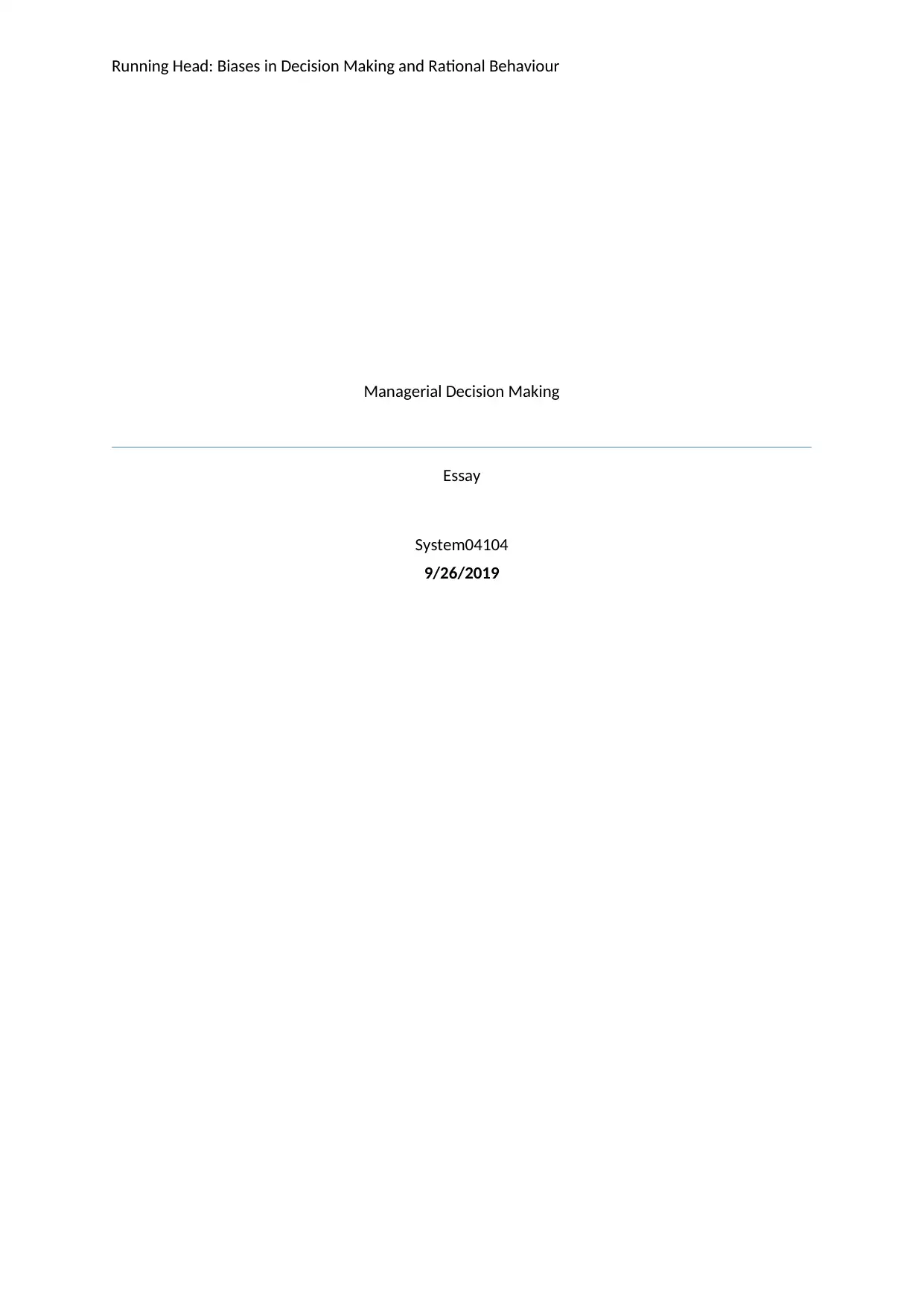
Running Head: Biases in Decision Making and Rational Behaviour
Managerial Decision Making
Essay
System04104
9/26/2019
Managerial Decision Making
Essay
System04104
9/26/2019
Paraphrase This Document
Need a fresh take? Get an instant paraphrase of this document with our AI Paraphraser
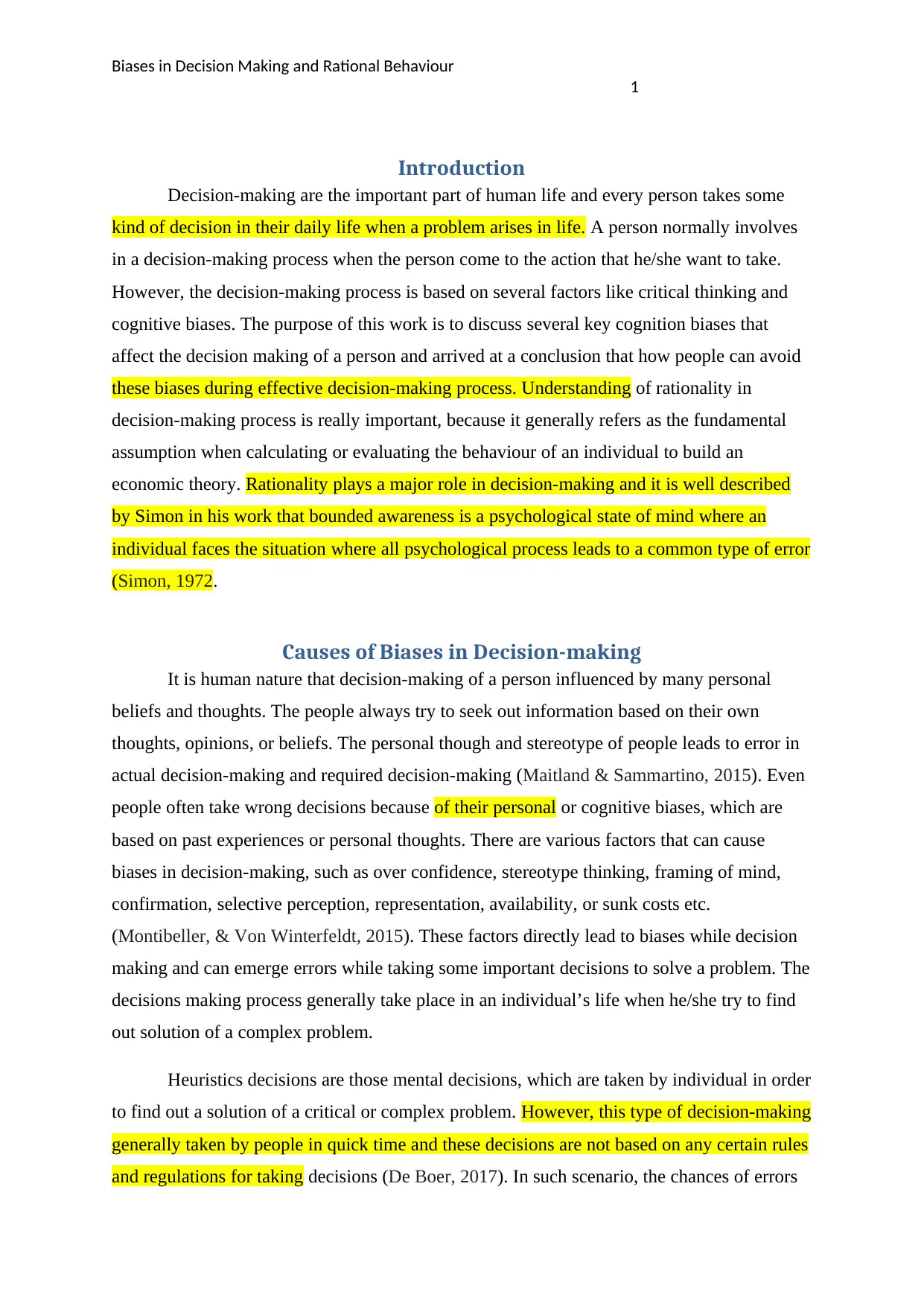
Biases in Decision Making and Rational Behaviour
1
Introduction
Decision-making are the important part of human life and every person takes some
kind of decision in their daily life when a problem arises in life. A person normally involves
in a decision-making process when the person come to the action that he/she want to take.
However, the decision-making process is based on several factors like critical thinking and
cognitive biases. The purpose of this work is to discuss several key cognition biases that
affect the decision making of a person and arrived at a conclusion that how people can avoid
these biases during effective decision-making process. Understanding of rationality in
decision-making process is really important, because it generally refers as the fundamental
assumption when calculating or evaluating the behaviour of an individual to build an
economic theory. Rationality plays a major role in decision-making and it is well described
by Simon in his work that bounded awareness is a psychological state of mind where an
individual faces the situation where all psychological process leads to a common type of error
(Simon, 1972.
Causes of Biases in Decision-making
It is human nature that decision-making of a person influenced by many personal
beliefs and thoughts. The people always try to seek out information based on their own
thoughts, opinions, or beliefs. The personal though and stereotype of people leads to error in
actual decision-making and required decision-making (Maitland & Sammartino, 2015). Even
people often take wrong decisions because of their personal or cognitive biases, which are
based on past experiences or personal thoughts. There are various factors that can cause
biases in decision-making, such as over confidence, stereotype thinking, framing of mind,
confirmation, selective perception, representation, availability, or sunk costs etc.
(Montibeller, & Von Winterfeldt, 2015). These factors directly lead to biases while decision
making and can emerge errors while taking some important decisions to solve a problem. The
decisions making process generally take place in an individual’s life when he/she try to find
out solution of a complex problem.
Heuristics decisions are those mental decisions, which are taken by individual in order
to find out a solution of a critical or complex problem. However, this type of decision-making
generally taken by people in quick time and these decisions are not based on any certain rules
and regulations for taking decisions (De Boer, 2017). In such scenario, the chances of errors
1
Introduction
Decision-making are the important part of human life and every person takes some
kind of decision in their daily life when a problem arises in life. A person normally involves
in a decision-making process when the person come to the action that he/she want to take.
However, the decision-making process is based on several factors like critical thinking and
cognitive biases. The purpose of this work is to discuss several key cognition biases that
affect the decision making of a person and arrived at a conclusion that how people can avoid
these biases during effective decision-making process. Understanding of rationality in
decision-making process is really important, because it generally refers as the fundamental
assumption when calculating or evaluating the behaviour of an individual to build an
economic theory. Rationality plays a major role in decision-making and it is well described
by Simon in his work that bounded awareness is a psychological state of mind where an
individual faces the situation where all psychological process leads to a common type of error
(Simon, 1972.
Causes of Biases in Decision-making
It is human nature that decision-making of a person influenced by many personal
beliefs and thoughts. The people always try to seek out information based on their own
thoughts, opinions, or beliefs. The personal though and stereotype of people leads to error in
actual decision-making and required decision-making (Maitland & Sammartino, 2015). Even
people often take wrong decisions because of their personal or cognitive biases, which are
based on past experiences or personal thoughts. There are various factors that can cause
biases in decision-making, such as over confidence, stereotype thinking, framing of mind,
confirmation, selective perception, representation, availability, or sunk costs etc.
(Montibeller, & Von Winterfeldt, 2015). These factors directly lead to biases while decision
making and can emerge errors while taking some important decisions to solve a problem. The
decisions making process generally take place in an individual’s life when he/she try to find
out solution of a complex problem.
Heuristics decisions are those mental decisions, which are taken by individual in order
to find out a solution of a critical or complex problem. However, this type of decision-making
generally taken by people in quick time and these decisions are not based on any certain rules
and regulations for taking decisions (De Boer, 2017). In such scenario, the chances of errors
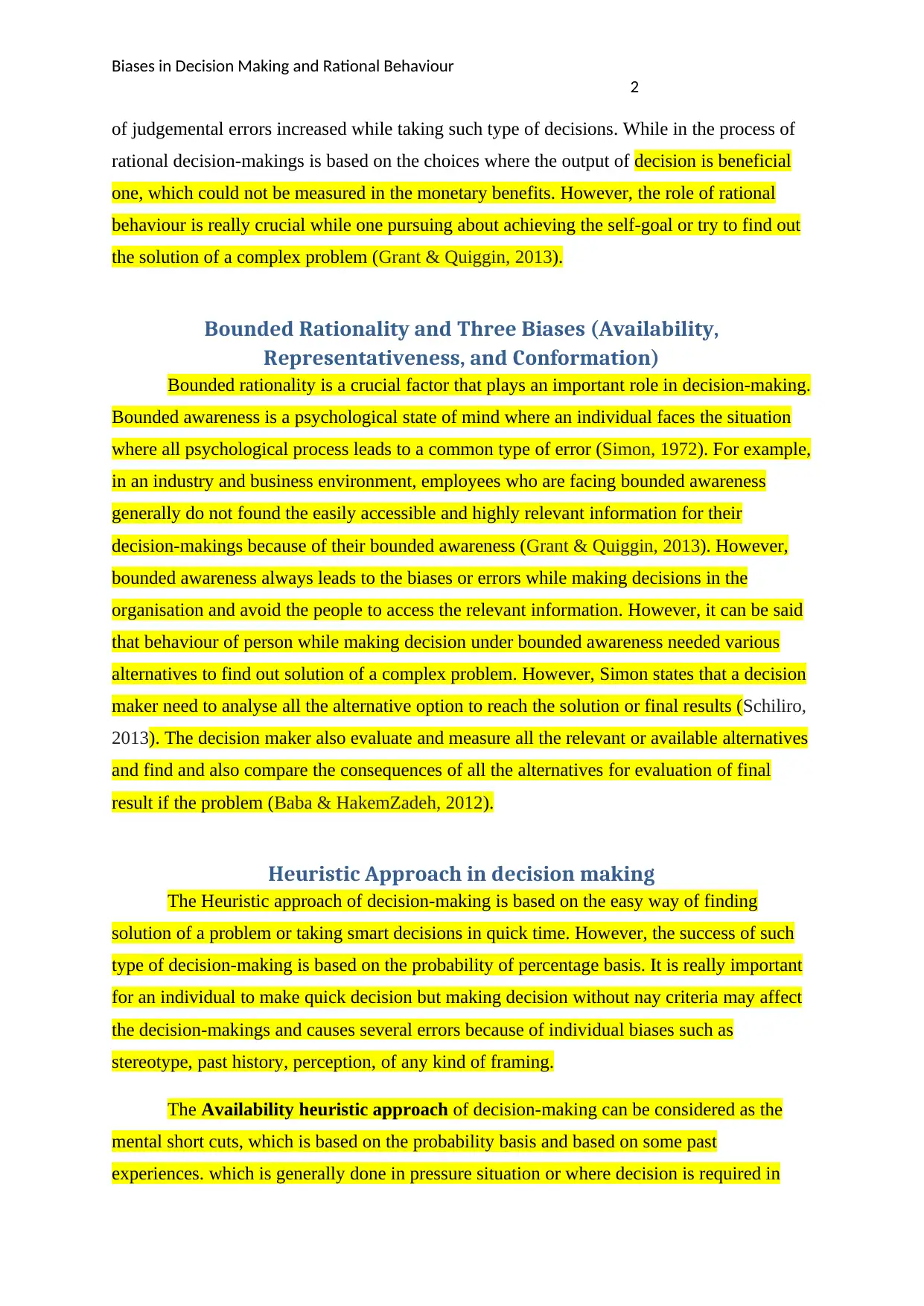
Biases in Decision Making and Rational Behaviour
2
of judgemental errors increased while taking such type of decisions. While in the process of
rational decision-makings is based on the choices where the output of decision is beneficial
one, which could not be measured in the monetary benefits. However, the role of rational
behaviour is really crucial while one pursuing about achieving the self-goal or try to find out
the solution of a complex problem (Grant & Quiggin, 2013).
Bounded Rationality and Three Biases (Availability,
Representativeness, and Conformation)
Bounded rationality is a crucial factor that plays an important role in decision-making.
Bounded awareness is a psychological state of mind where an individual faces the situation
where all psychological process leads to a common type of error (Simon, 1972). For example,
in an industry and business environment, employees who are facing bounded awareness
generally do not found the easily accessible and highly relevant information for their
decision-makings because of their bounded awareness (Grant & Quiggin, 2013). However,
bounded awareness always leads to the biases or errors while making decisions in the
organisation and avoid the people to access the relevant information. However, it can be said
that behaviour of person while making decision under bounded awareness needed various
alternatives to find out solution of a complex problem. However, Simon states that a decision
maker need to analyse all the alternative option to reach the solution or final results (Schiliro,
2013). The decision maker also evaluate and measure all the relevant or available alternatives
and find and also compare the consequences of all the alternatives for evaluation of final
result if the problem (Baba & HakemZadeh, 2012).
Heuristic Approach in decision making
The Heuristic approach of decision-making is based on the easy way of finding
solution of a problem or taking smart decisions in quick time. However, the success of such
type of decision-making is based on the probability of percentage basis. It is really important
for an individual to make quick decision but making decision without nay criteria may affect
the decision-makings and causes several errors because of individual biases such as
stereotype, past history, perception, of any kind of framing.
The Availability heuristic approach of decision-making can be considered as the
mental short cuts, which is based on the probability basis and based on some past
experiences. which is generally done in pressure situation or where decision is required in
2
of judgemental errors increased while taking such type of decisions. While in the process of
rational decision-makings is based on the choices where the output of decision is beneficial
one, which could not be measured in the monetary benefits. However, the role of rational
behaviour is really crucial while one pursuing about achieving the self-goal or try to find out
the solution of a complex problem (Grant & Quiggin, 2013).
Bounded Rationality and Three Biases (Availability,
Representativeness, and Conformation)
Bounded rationality is a crucial factor that plays an important role in decision-making.
Bounded awareness is a psychological state of mind where an individual faces the situation
where all psychological process leads to a common type of error (Simon, 1972). For example,
in an industry and business environment, employees who are facing bounded awareness
generally do not found the easily accessible and highly relevant information for their
decision-makings because of their bounded awareness (Grant & Quiggin, 2013). However,
bounded awareness always leads to the biases or errors while making decisions in the
organisation and avoid the people to access the relevant information. However, it can be said
that behaviour of person while making decision under bounded awareness needed various
alternatives to find out solution of a complex problem. However, Simon states that a decision
maker need to analyse all the alternative option to reach the solution or final results (Schiliro,
2013). The decision maker also evaluate and measure all the relevant or available alternatives
and find and also compare the consequences of all the alternatives for evaluation of final
result if the problem (Baba & HakemZadeh, 2012).
Heuristic Approach in decision making
The Heuristic approach of decision-making is based on the easy way of finding
solution of a problem or taking smart decisions in quick time. However, the success of such
type of decision-making is based on the probability of percentage basis. It is really important
for an individual to make quick decision but making decision without nay criteria may affect
the decision-makings and causes several errors because of individual biases such as
stereotype, past history, perception, of any kind of framing.
The Availability heuristic approach of decision-making can be considered as the
mental short cuts, which is based on the probability basis and based on some past
experiences. which is generally done in pressure situation or where decision is required in
⊘ This is a preview!⊘
Do you want full access?
Subscribe today to unlock all pages.

Trusted by 1+ million students worldwide
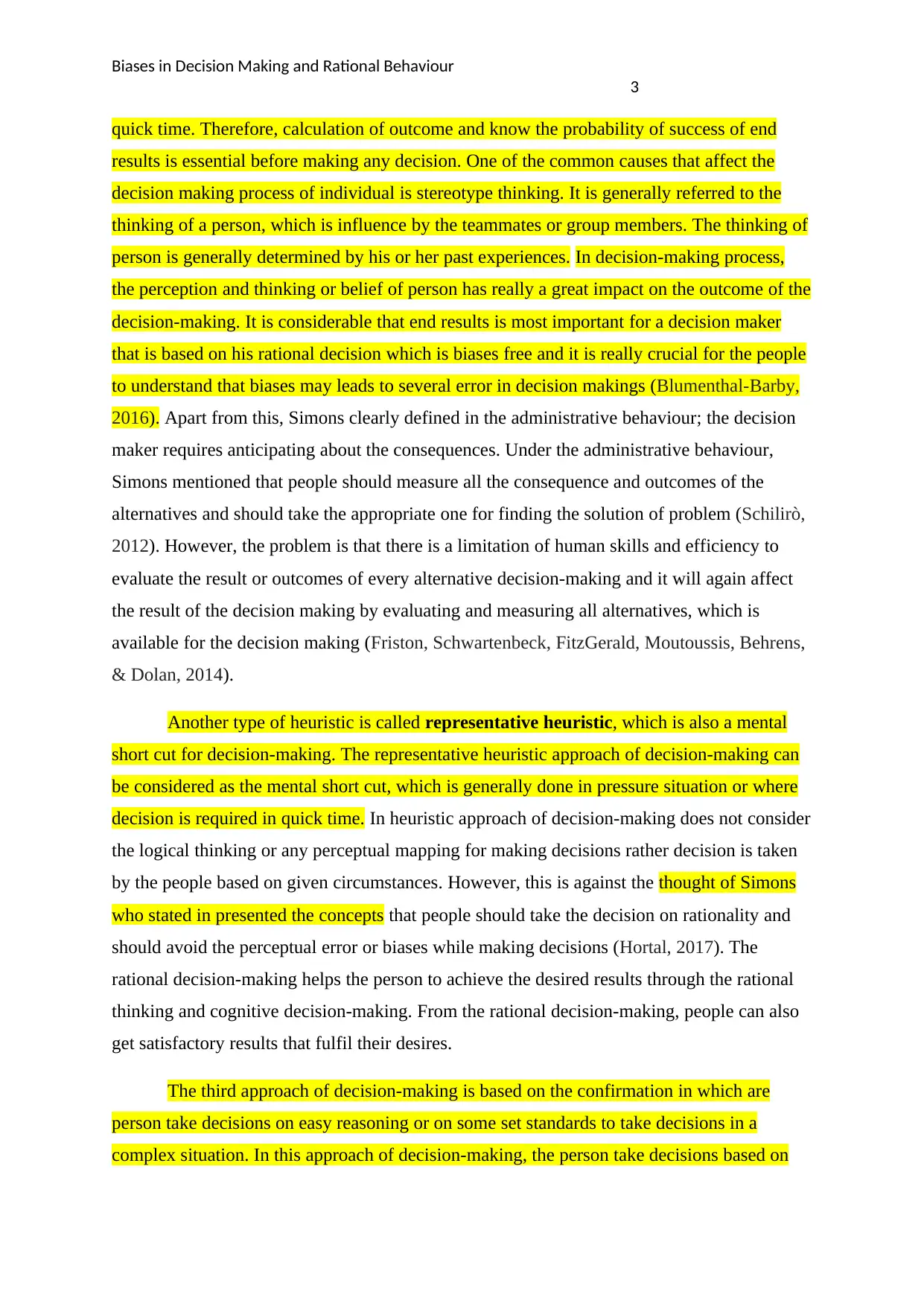
Biases in Decision Making and Rational Behaviour
3
quick time. Therefore, calculation of outcome and know the probability of success of end
results is essential before making any decision. One of the common causes that affect the
decision making process of individual is stereotype thinking. It is generally referred to the
thinking of a person, which is influence by the teammates or group members. The thinking of
person is generally determined by his or her past experiences. In decision-making process,
the perception and thinking or belief of person has really a great impact on the outcome of the
decision-making. It is considerable that end results is most important for a decision maker
that is based on his rational decision which is biases free and it is really crucial for the people
to understand that biases may leads to several error in decision makings (Blumenthal-Barby,
2016). Apart from this, Simons clearly defined in the administrative behaviour; the decision
maker requires anticipating about the consequences. Under the administrative behaviour,
Simons mentioned that people should measure all the consequence and outcomes of the
alternatives and should take the appropriate one for finding the solution of problem (Schilirò,
2012). However, the problem is that there is a limitation of human skills and efficiency to
evaluate the result or outcomes of every alternative decision-making and it will again affect
the result of the decision making by evaluating and measuring all alternatives, which is
available for the decision making (Friston, Schwartenbeck, FitzGerald, Moutoussis, Behrens,
& Dolan, 2014).
Another type of heuristic is called representative heuristic, which is also a mental
short cut for decision-making. The representative heuristic approach of decision-making can
be considered as the mental short cut, which is generally done in pressure situation or where
decision is required in quick time. In heuristic approach of decision-making does not consider
the logical thinking or any perceptual mapping for making decisions rather decision is taken
by the people based on given circumstances. However, this is against the thought of Simons
who stated in presented the concepts that people should take the decision on rationality and
should avoid the perceptual error or biases while making decisions (Hortal, 2017). The
rational decision-making helps the person to achieve the desired results through the rational
thinking and cognitive decision-making. From the rational decision-making, people can also
get satisfactory results that fulfil their desires.
The third approach of decision-making is based on the confirmation in which are
person take decisions on easy reasoning or on some set standards to take decisions in a
complex situation. In this approach of decision-making, the person take decisions based on
3
quick time. Therefore, calculation of outcome and know the probability of success of end
results is essential before making any decision. One of the common causes that affect the
decision making process of individual is stereotype thinking. It is generally referred to the
thinking of a person, which is influence by the teammates or group members. The thinking of
person is generally determined by his or her past experiences. In decision-making process,
the perception and thinking or belief of person has really a great impact on the outcome of the
decision-making. It is considerable that end results is most important for a decision maker
that is based on his rational decision which is biases free and it is really crucial for the people
to understand that biases may leads to several error in decision makings (Blumenthal-Barby,
2016). Apart from this, Simons clearly defined in the administrative behaviour; the decision
maker requires anticipating about the consequences. Under the administrative behaviour,
Simons mentioned that people should measure all the consequence and outcomes of the
alternatives and should take the appropriate one for finding the solution of problem (Schilirò,
2012). However, the problem is that there is a limitation of human skills and efficiency to
evaluate the result or outcomes of every alternative decision-making and it will again affect
the result of the decision making by evaluating and measuring all alternatives, which is
available for the decision making (Friston, Schwartenbeck, FitzGerald, Moutoussis, Behrens,
& Dolan, 2014).
Another type of heuristic is called representative heuristic, which is also a mental
short cut for decision-making. The representative heuristic approach of decision-making can
be considered as the mental short cut, which is generally done in pressure situation or where
decision is required in quick time. In heuristic approach of decision-making does not consider
the logical thinking or any perceptual mapping for making decisions rather decision is taken
by the people based on given circumstances. However, this is against the thought of Simons
who stated in presented the concepts that people should take the decision on rationality and
should avoid the perceptual error or biases while making decisions (Hortal, 2017). The
rational decision-making helps the person to achieve the desired results through the rational
thinking and cognitive decision-making. From the rational decision-making, people can also
get satisfactory results that fulfil their desires.
The third approach of decision-making is based on the confirmation in which are
person take decisions on easy reasoning or on some set standards to take decisions in a
complex situation. In this approach of decision-making, the person take decisions based on
Paraphrase This Document
Need a fresh take? Get an instant paraphrase of this document with our AI Paraphraser
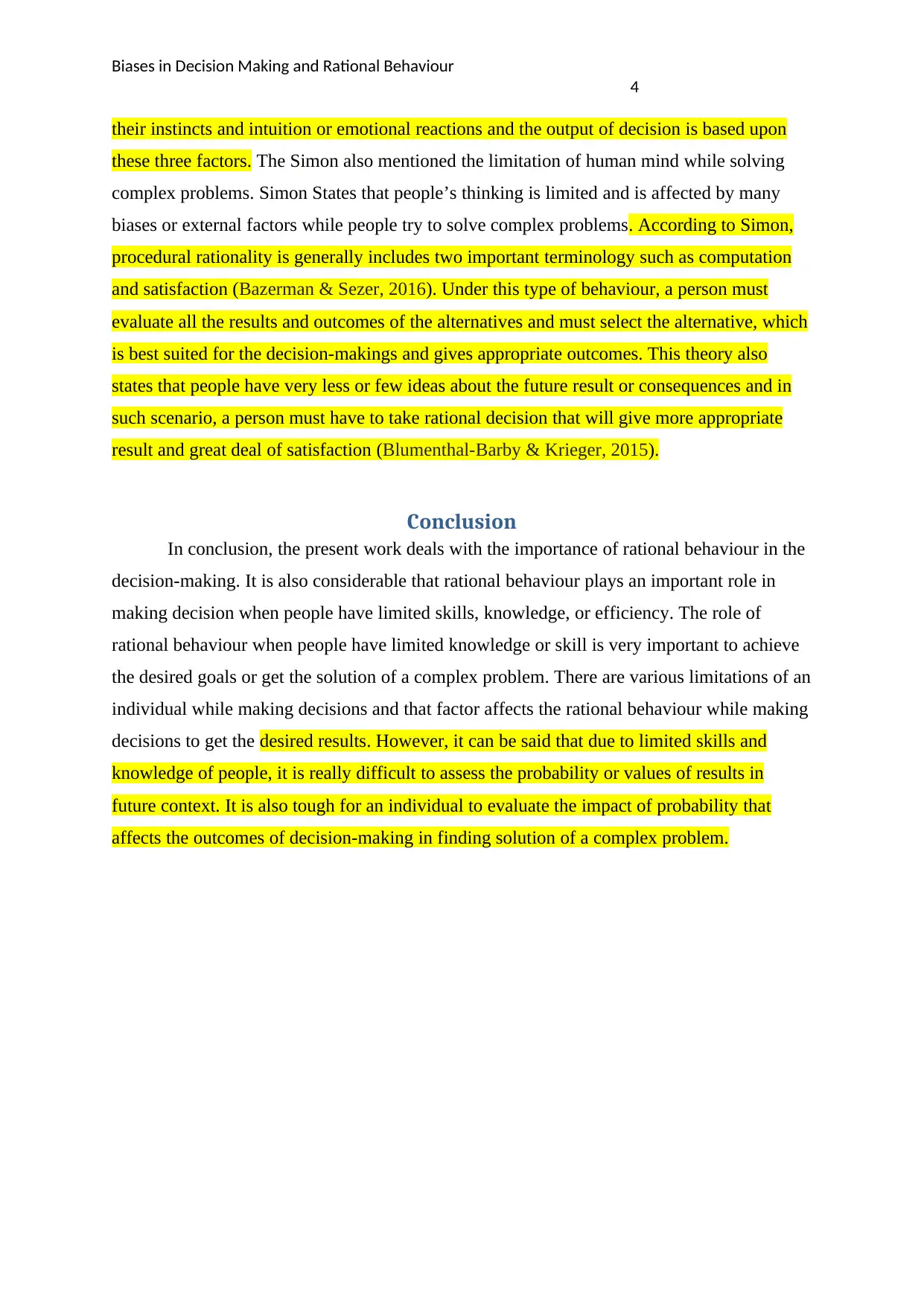
Biases in Decision Making and Rational Behaviour
4
their instincts and intuition or emotional reactions and the output of decision is based upon
these three factors. The Simon also mentioned the limitation of human mind while solving
complex problems. Simon States that people’s thinking is limited and is affected by many
biases or external factors while people try to solve complex problems. According to Simon,
procedural rationality is generally includes two important terminology such as computation
and satisfaction (Bazerman & Sezer, 2016). Under this type of behaviour, a person must
evaluate all the results and outcomes of the alternatives and must select the alternative, which
is best suited for the decision-makings and gives appropriate outcomes. This theory also
states that people have very less or few ideas about the future result or consequences and in
such scenario, a person must have to take rational decision that will give more appropriate
result and great deal of satisfaction (Blumenthal-Barby & Krieger, 2015).
Conclusion
In conclusion, the present work deals with the importance of rational behaviour in the
decision-making. It is also considerable that rational behaviour plays an important role in
making decision when people have limited skills, knowledge, or efficiency. The role of
rational behaviour when people have limited knowledge or skill is very important to achieve
the desired goals or get the solution of a complex problem. There are various limitations of an
individual while making decisions and that factor affects the rational behaviour while making
decisions to get the desired results. However, it can be said that due to limited skills and
knowledge of people, it is really difficult to assess the probability or values of results in
future context. It is also tough for an individual to evaluate the impact of probability that
affects the outcomes of decision-making in finding solution of a complex problem.
4
their instincts and intuition or emotional reactions and the output of decision is based upon
these three factors. The Simon also mentioned the limitation of human mind while solving
complex problems. Simon States that people’s thinking is limited and is affected by many
biases or external factors while people try to solve complex problems. According to Simon,
procedural rationality is generally includes two important terminology such as computation
and satisfaction (Bazerman & Sezer, 2016). Under this type of behaviour, a person must
evaluate all the results and outcomes of the alternatives and must select the alternative, which
is best suited for the decision-makings and gives appropriate outcomes. This theory also
states that people have very less or few ideas about the future result or consequences and in
such scenario, a person must have to take rational decision that will give more appropriate
result and great deal of satisfaction (Blumenthal-Barby & Krieger, 2015).
Conclusion
In conclusion, the present work deals with the importance of rational behaviour in the
decision-making. It is also considerable that rational behaviour plays an important role in
making decision when people have limited skills, knowledge, or efficiency. The role of
rational behaviour when people have limited knowledge or skill is very important to achieve
the desired goals or get the solution of a complex problem. There are various limitations of an
individual while making decisions and that factor affects the rational behaviour while making
decisions to get the desired results. However, it can be said that due to limited skills and
knowledge of people, it is really difficult to assess the probability or values of results in
future context. It is also tough for an individual to evaluate the impact of probability that
affects the outcomes of decision-making in finding solution of a complex problem.
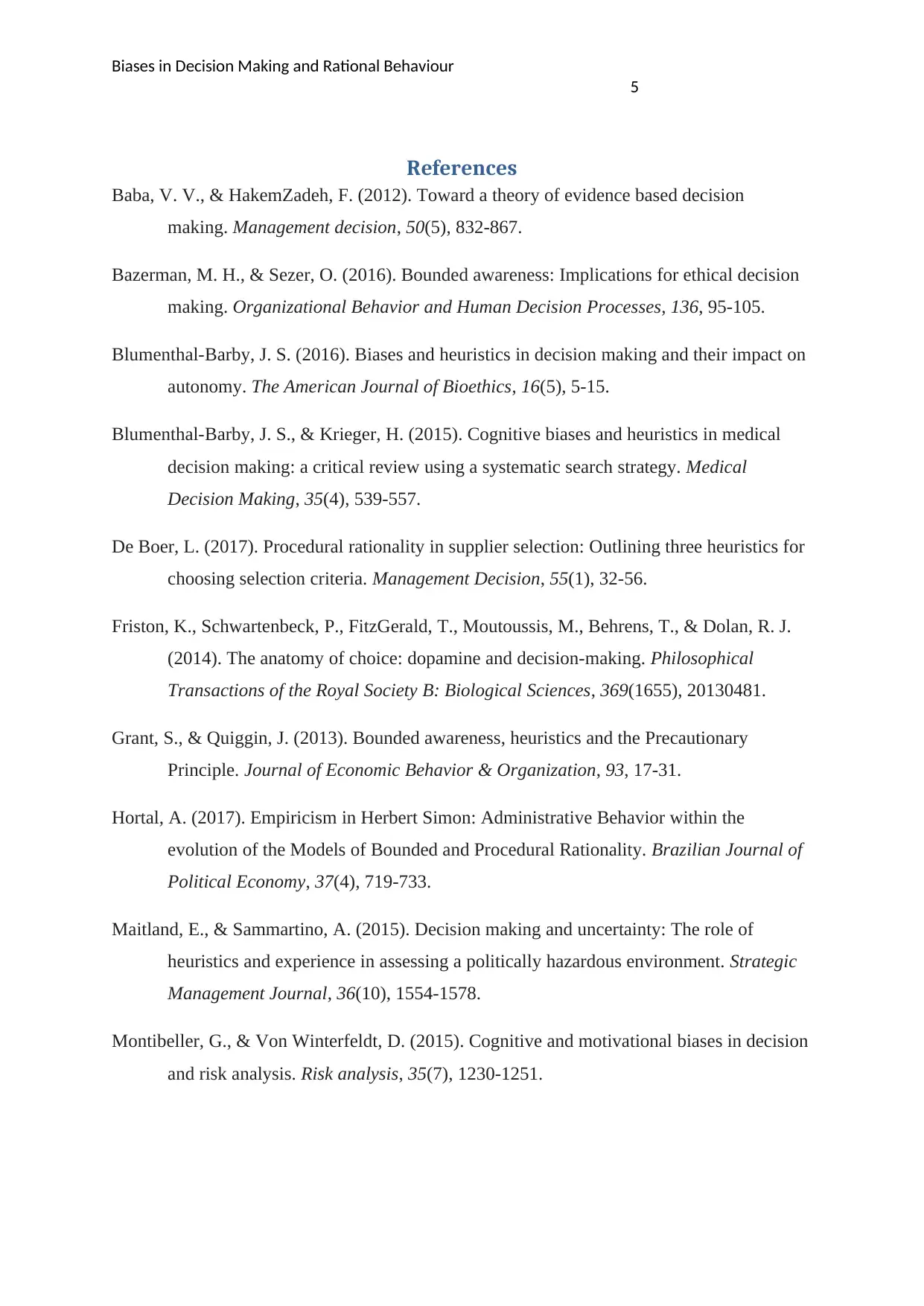
Biases in Decision Making and Rational Behaviour
5
References
Baba, V. V., & HakemZadeh, F. (2012). Toward a theory of evidence based decision
making. Management decision, 50(5), 832-867.
Bazerman, M. H., & Sezer, O. (2016). Bounded awareness: Implications for ethical decision
making. Organizational Behavior and Human Decision Processes, 136, 95-105.
Blumenthal-Barby, J. S. (2016). Biases and heuristics in decision making and their impact on
autonomy. The American Journal of Bioethics, 16(5), 5-15.
Blumenthal-Barby, J. S., & Krieger, H. (2015). Cognitive biases and heuristics in medical
decision making: a critical review using a systematic search strategy. Medical
Decision Making, 35(4), 539-557.
De Boer, L. (2017). Procedural rationality in supplier selection: Outlining three heuristics for
choosing selection criteria. Management Decision, 55(1), 32-56.
Friston, K., Schwartenbeck, P., FitzGerald, T., Moutoussis, M., Behrens, T., & Dolan, R. J.
(2014). The anatomy of choice: dopamine and decision-making. Philosophical
Transactions of the Royal Society B: Biological Sciences, 369(1655), 20130481.
Grant, S., & Quiggin, J. (2013). Bounded awareness, heuristics and the Precautionary
Principle. Journal of Economic Behavior & Organization, 93, 17-31.
Hortal, A. (2017). Empiricism in Herbert Simon: Administrative Behavior within the
evolution of the Models of Bounded and Procedural Rationality. Brazilian Journal of
Political Economy, 37(4), 719-733.
Maitland, E., & Sammartino, A. (2015). Decision making and uncertainty: The role of
heuristics and experience in assessing a politically hazardous environment. Strategic
Management Journal, 36(10), 1554-1578.
Montibeller, G., & Von Winterfeldt, D. (2015). Cognitive and motivational biases in decision
and risk analysis. Risk analysis, 35(7), 1230-1251.
5
References
Baba, V. V., & HakemZadeh, F. (2012). Toward a theory of evidence based decision
making. Management decision, 50(5), 832-867.
Bazerman, M. H., & Sezer, O. (2016). Bounded awareness: Implications for ethical decision
making. Organizational Behavior and Human Decision Processes, 136, 95-105.
Blumenthal-Barby, J. S. (2016). Biases and heuristics in decision making and their impact on
autonomy. The American Journal of Bioethics, 16(5), 5-15.
Blumenthal-Barby, J. S., & Krieger, H. (2015). Cognitive biases and heuristics in medical
decision making: a critical review using a systematic search strategy. Medical
Decision Making, 35(4), 539-557.
De Boer, L. (2017). Procedural rationality in supplier selection: Outlining three heuristics for
choosing selection criteria. Management Decision, 55(1), 32-56.
Friston, K., Schwartenbeck, P., FitzGerald, T., Moutoussis, M., Behrens, T., & Dolan, R. J.
(2014). The anatomy of choice: dopamine and decision-making. Philosophical
Transactions of the Royal Society B: Biological Sciences, 369(1655), 20130481.
Grant, S., & Quiggin, J. (2013). Bounded awareness, heuristics and the Precautionary
Principle. Journal of Economic Behavior & Organization, 93, 17-31.
Hortal, A. (2017). Empiricism in Herbert Simon: Administrative Behavior within the
evolution of the Models of Bounded and Procedural Rationality. Brazilian Journal of
Political Economy, 37(4), 719-733.
Maitland, E., & Sammartino, A. (2015). Decision making and uncertainty: The role of
heuristics and experience in assessing a politically hazardous environment. Strategic
Management Journal, 36(10), 1554-1578.
Montibeller, G., & Von Winterfeldt, D. (2015). Cognitive and motivational biases in decision
and risk analysis. Risk analysis, 35(7), 1230-1251.
⊘ This is a preview!⊘
Do you want full access?
Subscribe today to unlock all pages.

Trusted by 1+ million students worldwide
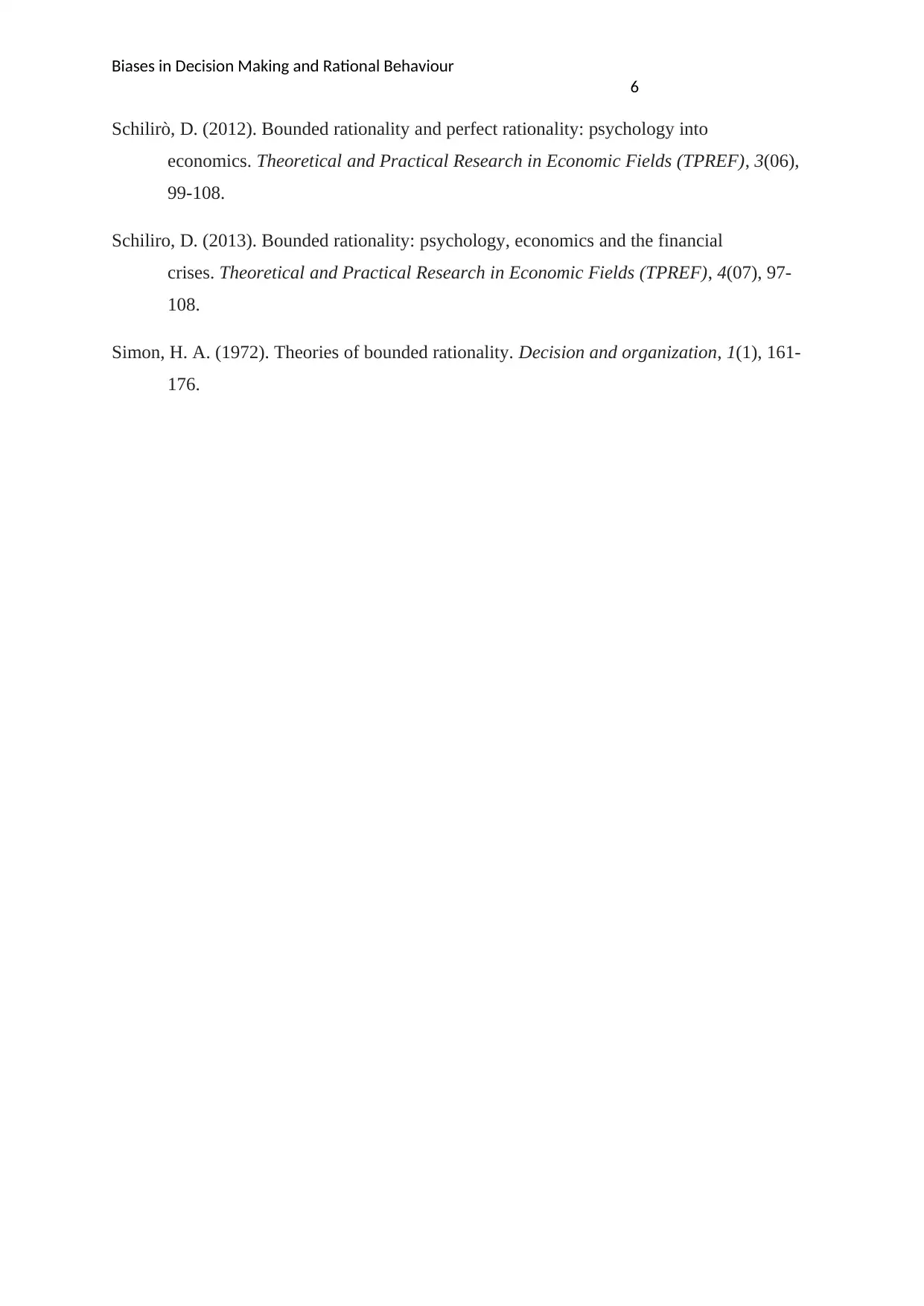
Biases in Decision Making and Rational Behaviour
6
Schilirò, D. (2012). Bounded rationality and perfect rationality: psychology into
economics. Theoretical and Practical Research in Economic Fields (TPREF), 3(06),
99-108.
Schiliro, D. (2013). Bounded rationality: psychology, economics and the financial
crises. Theoretical and Practical Research in Economic Fields (TPREF), 4(07), 97-
108.
Simon, H. A. (1972). Theories of bounded rationality. Decision and organization, 1(1), 161-
176.
6
Schilirò, D. (2012). Bounded rationality and perfect rationality: psychology into
economics. Theoretical and Practical Research in Economic Fields (TPREF), 3(06),
99-108.
Schiliro, D. (2013). Bounded rationality: psychology, economics and the financial
crises. Theoretical and Practical Research in Economic Fields (TPREF), 4(07), 97-
108.
Simon, H. A. (1972). Theories of bounded rationality. Decision and organization, 1(1), 161-
176.
1 out of 7
Related Documents
Your All-in-One AI-Powered Toolkit for Academic Success.
+13062052269
info@desklib.com
Available 24*7 on WhatsApp / Email
![[object Object]](/_next/static/media/star-bottom.7253800d.svg)
Unlock your academic potential
Copyright © 2020–2025 A2Z Services. All Rights Reserved. Developed and managed by ZUCOL.





